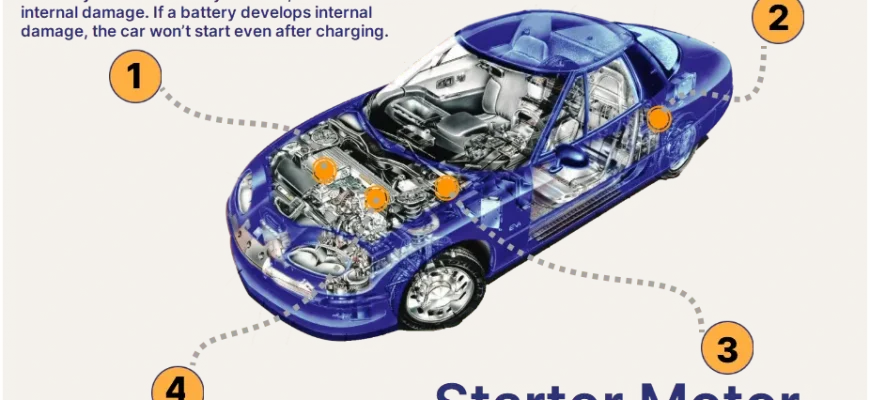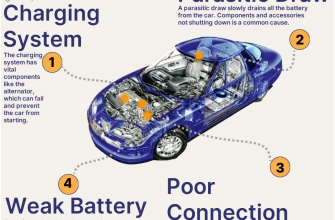There’s nothing more frustrating than a brand-new car refusing to start, especially when you know the battery is fresh. Whether it’s your first car or the latest model in your driveway, a non-starting vehicle can throw a wrench in your day. Fear not! Here are some troubleshooting tips to help you diagnose and potentially resolve the issue.
- 1. Check the Battery Connections
- 2. Verify the Key Fob and Ignition System
- 3. Check for Electrical Issues
- 4. Examine Fuel Supply
- 5. Look for Warning Lights
- 6. Consult the Owner’s Manual
- 7. Seek Professional Help
- 8. Examine the Alternator
- 9. Assess the Starter Relay and Solenoid
- 10. Look for Security System Issues
- 11. Inspect the Neutral Safety Switch
- 12. Seek Assistance from Roadside Services
1. Check the Battery Connections
Even with a new battery, poor connections can lead to starting problems. Start with the basics:
- Inspect the terminals: Make sure the battery terminals are clean and free from corrosion. A buildup of dirt or rust can prevent a proper connection.
- Ensure a snug fit: Verify that the cables are tightly secured to the battery terminals. Loose connections can interrupt the electrical flow.
2. Verify the Key Fob and Ignition System
If your car uses a key fob, it’s worth checking:
- Battery in the key fob: A weak or dead key fob battery can prevent the car from starting. Replace the battery and try again.
- Ignition switch: If you hear no sound when turning the key, the ignition switch could be faulty. Test the ignition by trying a spare key, if available.
3. Check for Electrical Issues
A brand-new battery doesn’t mean the electrical system is flawless:
- Fuses: Inspect the fuse box for blown fuses. A blown fuse could disrupt the starting circuit.
- Starter motor: Listen for a clicking sound when trying to start the car. If you hear it, the starter motor may be failing.
4. Examine Fuel Supply
Sometimes, the problem isn’t electrical but rather fuel-related:
- Fuel gauge: Double-check the fuel gauge to ensure there’s gas in the tank. It sounds simple, but it’s an easy oversight!
- Fuel pump: When starting, listen for a humming sound from the fuel pump. If you don’t hear it, the pump might be malfunctioning.
5. Look for Warning Lights
Modern vehicles come equipped with various warning lights. Check your dashboard for any alerts that might indicate an issue:
- Check Engine light: If illuminated, a diagnostic scan may reveal underlying issues.
- Battery warning light: This light indicates a problem with the battery or charging system.
6. Consult the Owner’s Manual
Your vehicle’s owner manual can be an invaluable resource. It may offer troubleshooting tips specific to your model or advise you on resetting the electrical system.
7. Seek Professional Help
If all else fails and your car still won’t start, it may be time to consult a professional mechanic. They have the tools and expertise to diagnose complex issues that may be beyond a standard troubleshooting approach.
Experiencing a no-start condition in a new battery car can be disheartening, but with a systematic approach, you can often identify the root cause. Start with the basics, check electrical connections, and don’t hesitate to reach out for professional assistance if needed. Remember, troubleshooting is often a process of elimination, and patience is key!
Next time your new car won’t start, you’ll be better prepared to tackle the issue with confidence!
As you navigate the challenges of diagnosing a non-starting car, it’s essential to remain calm and methodical. Here are additional troubleshooting steps that can help you get to the bottom of the issue:
8. Examine the Alternator
The alternator is a crucial component of your vehicle’s electrical system. It charges the battery while the engine is running. If your car starts but then dies shortly after, the alternator may be failing:
- Test the alternator: You can check if the alternator is working by using a multimeter. A healthy alternator typically produces between 13.7 to 14.7 volts.
- Look for warning signs: Dim lights, electrical malfunctions, or unusual noises from the engine compartment may indicate an alternator issue.
9. Assess the Starter Relay and Solenoid
The starter relay and solenoid play pivotal roles in the starting process. If these components are faulty, they can prevent your car from starting:
- Listen for sounds: If you hear a clicking sound but the engine doesn’t crank, the solenoid may be at fault.
- Check the relay: Swap the starter relay with another relay of the same type in the fuse box to see if that resolves the issue.
10. Look for Security System Issues
Modern vehicles often come with built-in anti-theft systems that can sometimes malfunction and prevent starting:
- Check for security indicators: If your dashboard has a security light flashing, your vehicle’s immobilizer might be engaged.
- Follow the reset procedure: Refer to your owner’s manual for instructions on how to reset the security system.
11. Inspect the Neutral Safety Switch
This switch ensures that the car can only be started in ‘Park’ or ‘Neutral’ gears. If this switch is malfunctioning, it may prevent the engine from starting:
- Shift gears: Try moving the gear shift between ‘Park’ and ‘Neutral’ to see if the engine starts.
- Check for faults: If the switch is faulty, it may need to be replaced by a professional.
12. Seek Assistance from Roadside Services
If troubleshooting doesn’t yield results, don’t hesitate to call for roadside assistance. They can provide on-the-spot diagnostics and help you understand whether you need to be towed to a mechanic or if a quick fix is possible.
With these troubleshooting tips in your toolkit, you can approach your car’s starting issues with confidence and clarity.










Great read! The step-by-step approach made it simple for me to diagnose my car’s starting problem. Thank you for the helpful advice!
What an informative piece! The section on electrical issues was especially eye-opening for me. I appreciate the straightforward explanations.
I found this article incredibly helpful! It’s perfect for someone like me who knows little about cars. Thanks for breaking it down so well!
Fantastic tips! I never thought about checking the key fob battery. This article saved me a trip to the mechanic. Very useful information!
This article is a lifesaver! I had no idea where to start when my car wouldn’t start. The troubleshooting tips are clear and easy to follow. Highly recommend!
I love how thorough this guide is! It covers all the bases from battery connections to fuel supply. I feel much more confident tackling car issues now.